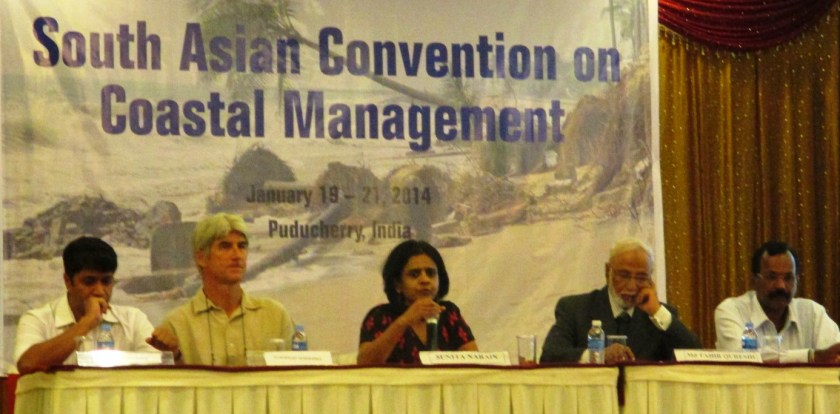News feature published in Ceylon Today broadsheet newspaper, 23 January 2014

South Asian Coasts Reeling Under Pressure
By Nalaka Gunawardene in Pondicherry, India
As economic development gathers pace in South Asia, its coastal regions are coming under pressure as never before. More ports, power plants and tourist resorts are jostling with fishermen and farmers.
Balancing livelihoods, economic growth and environmental conservation is the only way to avoid a major resource crisis, acknowledged participants at the South Asia Convention on Coastal Management held in Pondicherry, India, from 19 to 21 January 2014.
Over 70 senior government officials, researchers, civil society activists and journalists from Bangladesh, India, Maldives, Pakistan and Sri Lanka came together for this event, organised by Delhi-based Centre for Science and Environment (CSE) and Pondicherry-based citizen group, PondyCAN.
They reported how a disproportionately high share of South Asia’s industrialisation, urbanisation and tourism development is concentrated along its combined 11,240 km of coastline. In total, coastal areas support livelihoods of some 400 million South Asians through fisheries, tourism and other activities.
In many parts of the region, high population density exists alongside sensitive ecosystems – such as mangroves and coral reefs and river estuaries. This intensifies the challenge of managing coastal resources. Climate change impacts, already felt as extreme weather events, add to these pressures.
Participants discussed strategies for regulating coastal development, protecting coastal habitats and coping with climate change.
They agreed on the urgent need for improving scientific understanding of coastal regions, which begins with clearly defining, demarcating and mapping such areas. Evidence based policy making and effective regulation depend on such a knowledge base, currently lacking or inadequate.
“There is a need to strengthen regulatory systems, build capacity and do more research to better manage coastal challenges in South Asia,” said Sunita Narain, Director General of CSE.
In CSE’s view, she said, the most important intervention is to strengthen existing institutions to get them to deliver with greater transparency and accountability.
She added: “We need to balance conservation with benefits to local communities. We also need partnerships between conservation, development and livelihoods without which coastal resource management is not possible in a region like South Asia”.
Ibrahim Naeem, Director of the SAARC Coastal Zone Management Centre, located in the Maldives, explained the value of integrated coastal zone management (ICZM) in balancing competing interests.
Only such an approach can reconcile the many pressures faced by South Asia’s maritime countries including poverty, depleting resources, increasing hazards and large scale enterprises seeking quick profits from the coastal resources.
“We need to make sure these plans incorporate climate change to make them more meaningful to countries like ours,” he added.
Large scale infrastructure development projects are adding to other pressures. India – which already has 202 commercial ports and 27 thermal power plants on its coastline – is planning another 76 ports and 59 power plants. Over 70% of Sri Lanka’s tourist hotels are located in the coastal zone, with more coming up. The scramble for the coast is increasing in other countries, too.
Meanwhile, over two thirds of the world’s ship breaking takes place on open beaches in Bangladesh, India and Pakistan with little regard for worker health or environmental pollution. It is a highly hazardous industry with lucrative returns for operators.
Participants agreed on the need for the South Asian countries to share experiences and approaches and to learn from each other.
“It is important for South Asian countries to learn from each other’s successes and failures,” said Dr Anil Premaratne, Director General of Sri Lanka’s Coast Conservation Department.
Premaratne pointed out that laws and regulations are just one strategy for better managing coastal areas. Other strategies include awareness raising and public education, and the involvement of local communities in resource management and benefit sharing.
Participants also stressed the need for placing all scientific information and maps in the public domain. Right now, these are often trapped in state agencies or research institutes, with no easy access to researchers or other citizens.
Probir Banerjee, President PondyCAN, stressed that the “worst affected are the people living at the margins and the objective has to be to enhance livelihoods, and not compromise them.”